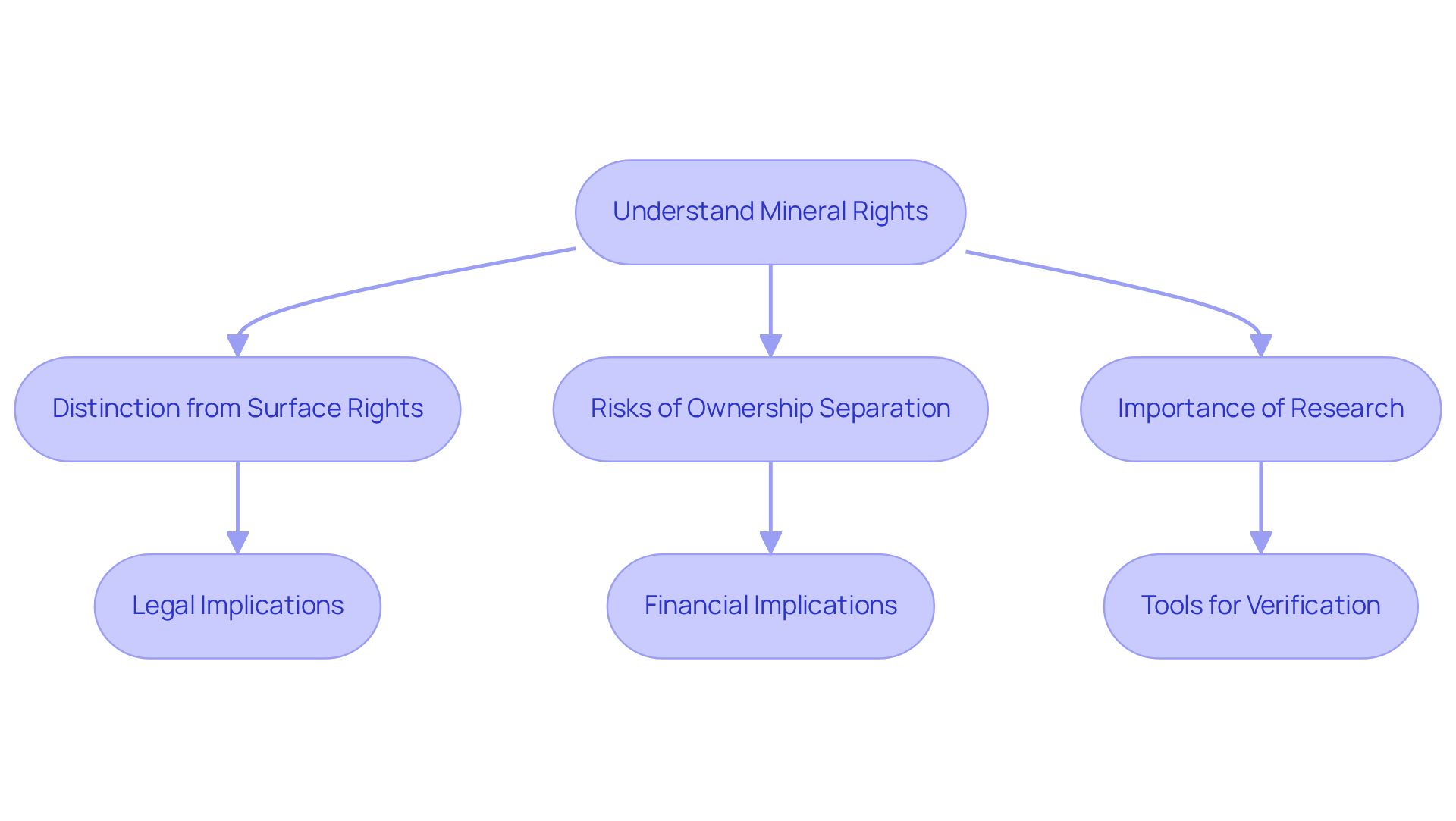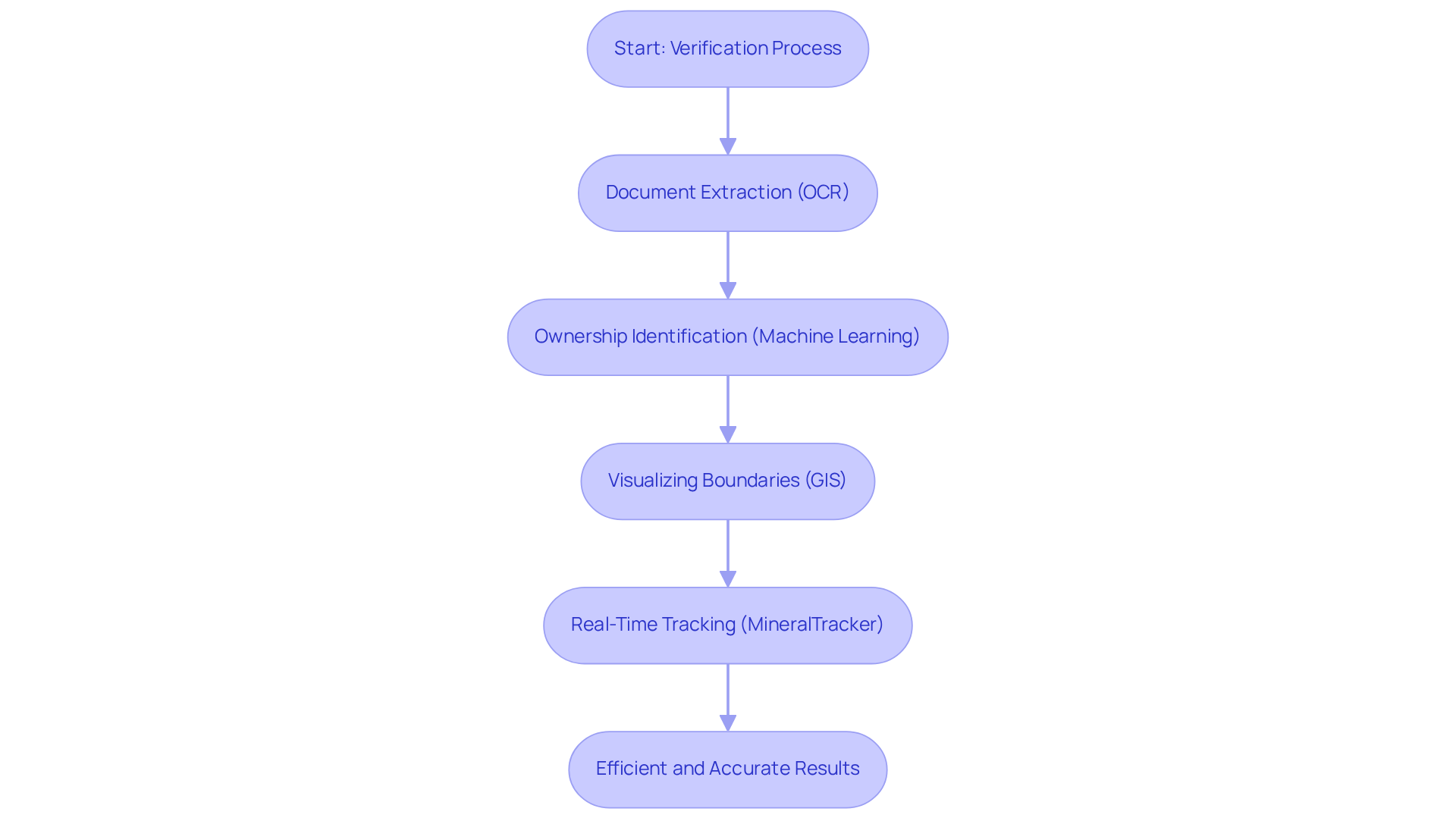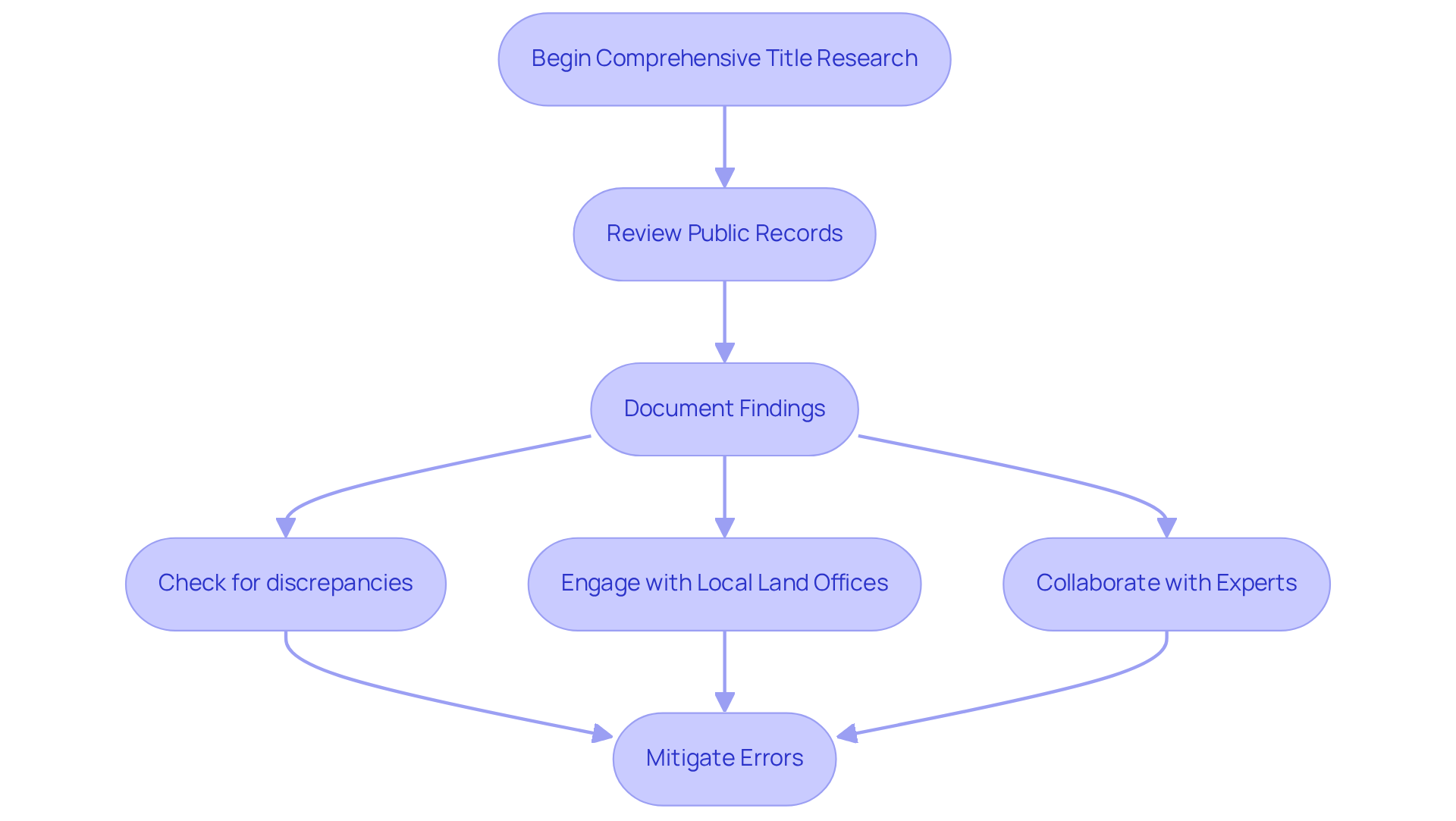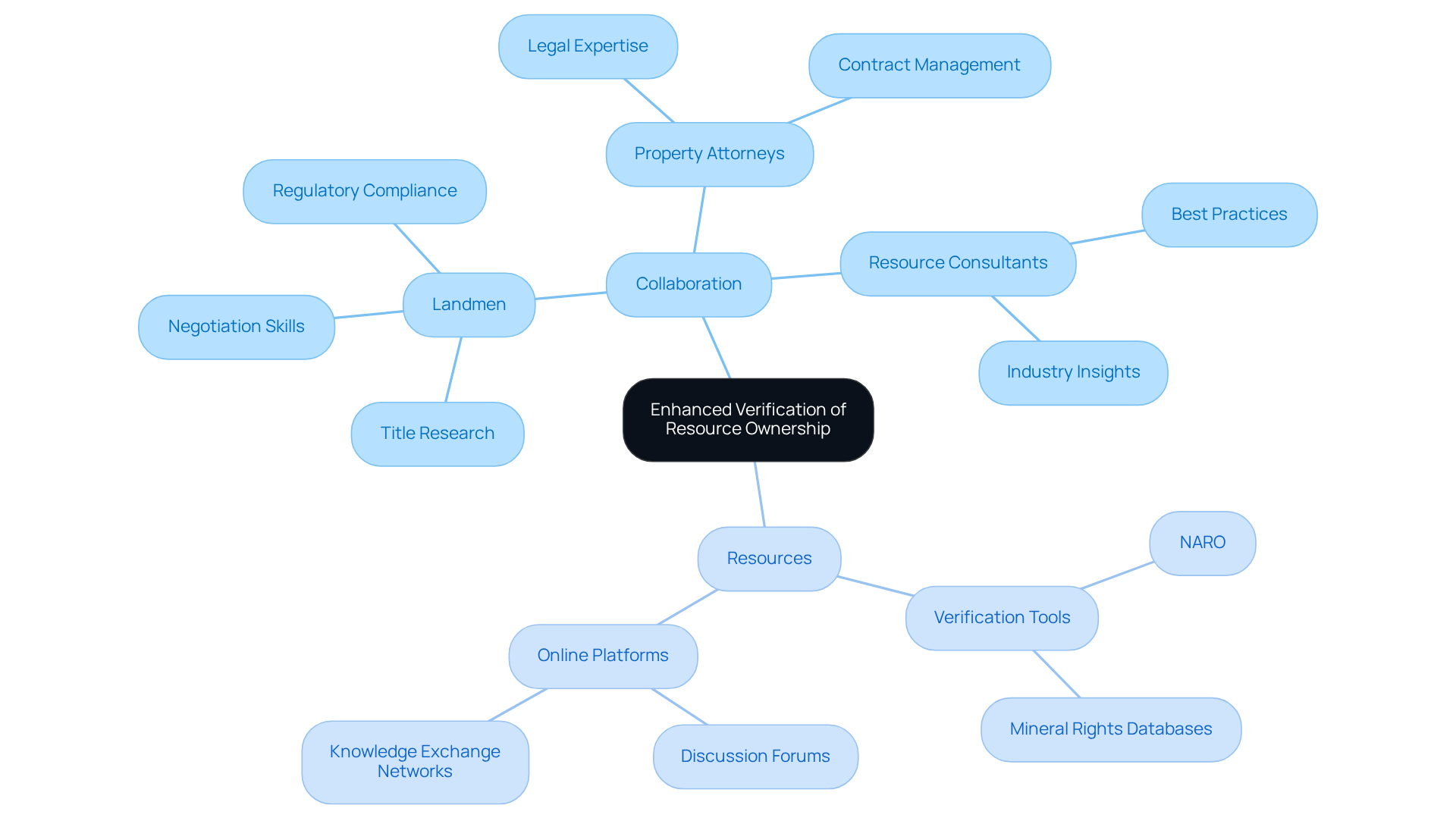Overview
The article underscores the essential tools for mineral rights verification that enhance title research, highlighting their critical role in accurately identifying ownership and mitigating legal risks in property transactions.
It elaborates on how advanced technologies, best practices in document research, and collaboration with experts can significantly improve the verification process.
Consequently, this approach safeguards investments and reduces the likelihood of disputes over resource ownership.
Introduction
Understanding mineral rights is crucial for anyone involved in property transactions, as these rights can significantly impact ownership and financial outcomes. The potential for costly disputes arising from overlooked resource entitlements underscores the paramount need for effective verification tools.
How can title researchers leverage technology and best practices to ensure accurate identification of mineral rights? Furthermore, what challenges might they face in navigating this complex landscape? Addressing these questions is essential for establishing a robust framework for property transactions.
Understand Mineral Rights and Their Importance in Title Research
Subsurface resources encompass valuable materials located beneath a property's surface, including oil, gas, coal, and other substances. This ownership is distinct from surface entitlements, which pertain to the land itself. In many instances, resource ownership can be separated from the surface property, indicating that the surface holder may lack the authority to extract or benefit from the substances below. This separation can result in significant legal and financial implications during property transactions.
For example, if a buyer is unaware that resource entitlements are owned by another entity, they may encounter unforeseen claims or disputes post-acquisition, potentially resulting in substantial financial losses. Data indicates that purchasing or leasing resource ownership without thorough research can lead to considerable financial setbacks, highlighting the necessity for using tools for mineral rights verification in diligent inquiries into resource ownership.
Furthermore, research on headings can mitigate these risks by identifying potential issues in advance. The U.S. administration reports that 57.2 million acres of federal resources lie beneath private land, emphasizing the importance of understanding resource entitlements in property dealings.
Therefore, a comprehensive understanding of resource entitlements, along with tools for mineral rights verification, is crucial for title investigators to ensure clear ownership and protect real estate investments. This diligence not only safeguards buyers but also minimizes risks associated with competing claims and unresolved title issues, which can delay or jeopardize operations in resource management.

Leverage Technology for Efficient Mineral Rights Verification
The incorporation of advanced technologies such as machine learning and optical character recognition (OCR) is revolutionizing the tools for mineral rights verification. By automating the extraction and analysis of title documents, title researchers can swiftly identify ownership records and evaluate resource assets. Geographic Information Systems (GIS) are pivotal in this process, as they visualize property boundaries and resource rights, thereby simplifying the identification of potential conflicts.
Furthermore, tools for mineral rights verification, including MineralTracker, facilitate real-time tracking of mineral interests and royalty payments, ensuring that stakeholders remain informed and compliant with legal obligations. By harnessing these technologies, researchers significantly reduce the time spent on manual searches while enhancing the accuracy of their findings.
This transformation not only optimizes workflows but also aligns with industry leaders' perspectives on the necessity of adopting machine learning to improve operational efficiency in research.

Implement Best Practices for Comprehensive Title Research
To conduct comprehensive document research, it is essential to adhere to best practices that guarantee thoroughness and accuracy. Begin with a meticulous review of public records, such as property deeds, tax records, and court documents. This critical step establishes a clear sequence of authority, as approximately 20% of research errors stem from incomplete records.
Furthermore, employ a systematic approach to document all findings, carefully noting any discrepancies or incomplete records that may necessitate further investigation. Engaging with local land offices and leveraging online databases can provide additional context and serve as tools for mineral rights verification.
In addition, collaborating with knowledgeable landmen or firms that utilize tools for mineral rights verification can enhance understanding of intricate legal terminology and historical property matters. Chain of Title issues can lead to conflicts regarding ownership and financial losses due to document flaws, underscoring the importance of adhering to these best practices.
By following these guidelines, researchers can significantly mitigate the risk of errors and bolster the reliability of their reports.

Collaborate with Experts and Utilize Resources for Enhanced Verification
Cooperation is vital for enhancing the validation of resource ownership. Engaging with specialists such as landmen, property attorneys, and resource consultants provides crucial insights and expertise, which can be further enhanced by using tools for mineral rights verification that traditional research methods may not easily yield.
For example, landmen possess extensive knowledge of local regulations and historical land use, which is essential in navigating complex ownership disputes. Furthermore, leveraging tools for mineral rights verification, such as the National Association of Royalty Owners (NARO), connects researchers with a network of professionals dedicated to resource ownership.
Online platforms and forums focused on mineral rights discussions also serve as invaluable resources for exchanging knowledge and best practices. By fostering collaboration and utilizing tools for mineral rights verification, title researchers can significantly enhance their verification processes, leading to more accurate outcomes.

Conclusion
Understanding and verifying mineral rights is paramount for anyone engaged in property transactions, as the ownership of subsurface resources can markedly differ from surface rights. This separation can result in intricate legal and financial challenges, underscoring the necessity for title researchers to employ effective tools for mineral rights verification. This article has elucidated the critical importance of thorough research and the technologies that can augment this process, ensuring stakeholders are well-informed and protected.
Key insights discussed include the transformative impact of advanced technologies, such as machine learning and GIS, which streamline the verification process and enhance accuracy. Best practices in document research, including meticulous reviews of public records and collaboration with experts, are essential in minimizing errors and ensuring comprehensive title research. Engaging with knowledgeable professionals and leveraging specialized tools not only deepens understanding but also yields valuable insights into complex ownership matters.
Ultimately, the importance of diligent mineral rights verification cannot be overstated. By prioritizing thorough research and embracing technological advancements, stakeholders can safeguard their investments and adeptly navigate the complexities of resource ownership. Adopting these best practices and tools will lead to more informed decisions, ultimately fostering a more secure and efficient real estate market.
Frequently Asked Questions
What are mineral rights and why are they important in title research?
Mineral rights refer to the ownership of subsurface resources such as oil, gas, and coal, which are distinct from surface rights pertaining to the land itself. Understanding mineral rights is crucial in title research to avoid legal and financial implications during property transactions.
How can the separation of mineral rights from surface rights impact property transactions?
The separation can lead to situations where the surface property owner lacks the authority to extract or benefit from subsurface resources. This can result in unforeseen claims or disputes after a property acquisition, potentially causing substantial financial losses.
What risks are associated with purchasing or leasing mineral rights without thorough research?
Purchasing or leasing mineral rights without thorough research can lead to considerable financial setbacks due to unexpected claims or disputes regarding resource ownership that may arise after the transaction.
How can research on headings help mitigate risks related to mineral rights?
Research on headings can identify potential issues related to mineral rights in advance, helping to mitigate risks and ensuring that all parties are aware of existing claims or disputes before completing a transaction.
What does the U.S. administration report about federal resources beneath private land?
The U.S. administration reports that 57.2 million acres of federal resources lie beneath private land, highlighting the importance of understanding resource entitlements in property dealings.
Why is it essential for title investigators to understand resource entitlements?
A comprehensive understanding of resource entitlements allows title investigators to ensure clear ownership, protect real estate investments, and minimize risks associated with competing claims and unresolved title issues.




